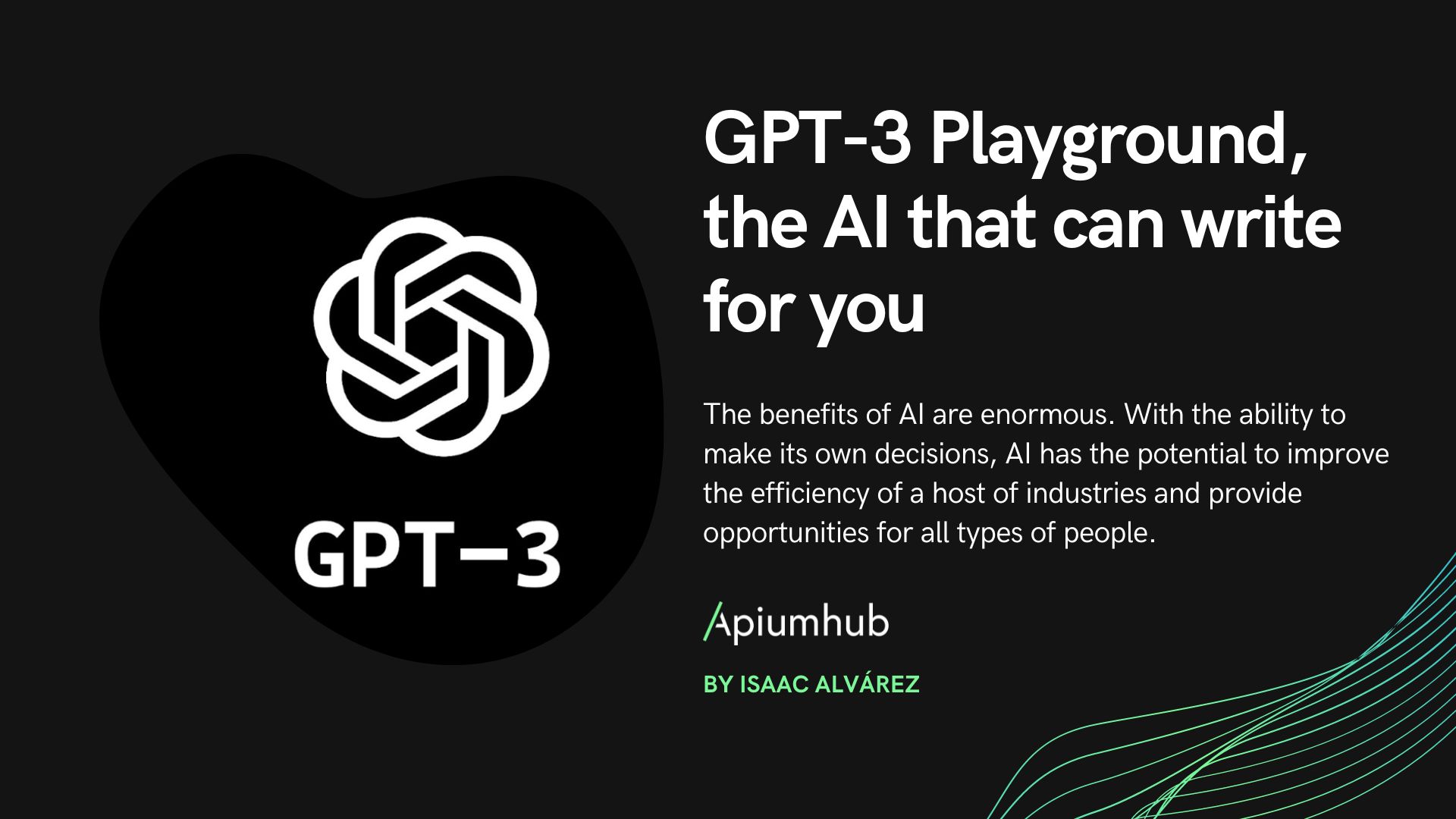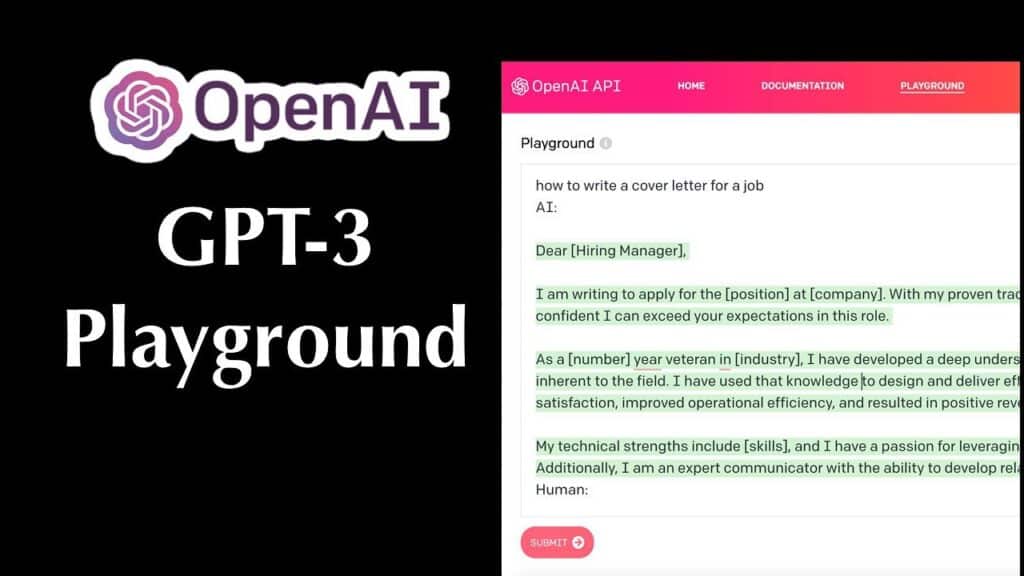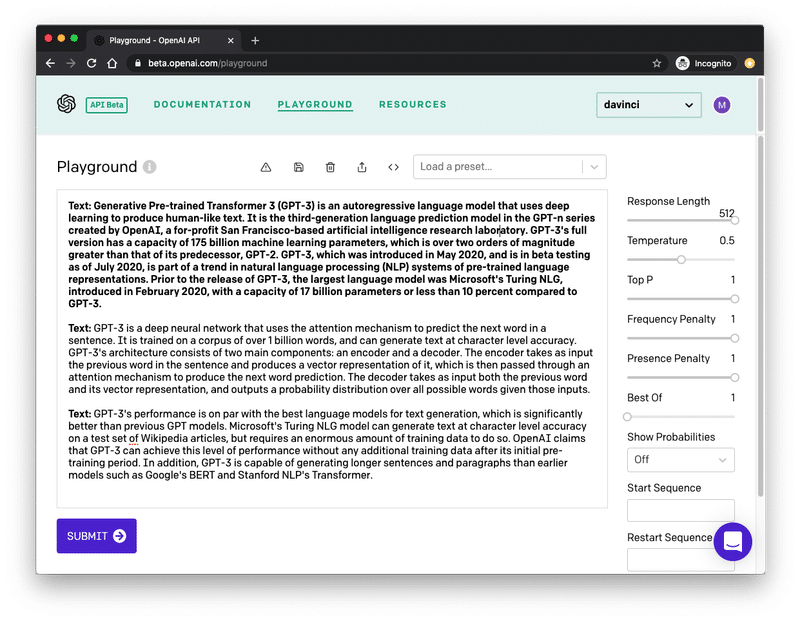The advanced language model known as Generative Pre-trained Transformer 3 (GPT-3) was created by OpenAI and has received a lot of attention for its amazing natural language interpretation and generation capabilities. GPT-3 can do a variety of tasks, like answering questions, writing text, summarising data, translating languages, and much more, by utilizing deep learning and a sizable dataset.
An interactive web-based platform called the GPT-3 Playground was created to let people play with and take use of the GPT-3 language model’s potential. It is a crucial tool for programmers, academics, and AI enthusiasts who wish to investigate the capabilities of the model and test out various prompts and settings. The GPT-3 Playground enables users to evaluate the AI’s capabilities in a variety of tasks and obtain insights into its strengths and limitations by offering an approachable and user-friendly interface. The platform’s ultimate goal is to promote creativity and innovation in the fields of natural language processing and artificial intelligence.
Getting Started with the GPT-3 Playground
Accessing the GPT-3 Playground:
You’ll need to go to OpenAI’s website (https://www.openai.com/) to access the GPT-3 Playground. Please be aware that the Playground may need an invitation or permission since it is occasionally only made available to a select group of users during the testing phase. Watch the official announcements and updates from OpenAI to find out when the Playground is open to the public.
Setting up an API key and authorization:
A GPT-3 Playground API key must be obtained from OpenAI before using it. To configure your API key and authorization, follow these steps:
- Sign up for an OpenAI account, if you don’t have one already.
- Apply for access to the GPT-3 API. OpenAI provides API access to its models on a case-by-case basis, and there might be a waitlist depending on the demand.
- Once your API access is granted, log in to your OpenAI account, and navigate to the API dashboard.
- In the dashboard, locate your API key. This key is a unique identifier used for authenticating your requests to the GPT-3 API.
- Copy the API key and keep it secure, as it will be required for accessing the GPT-3 Playground and making API calls.
- To authorize your API key in the Playground, paste the key into the designated input field or add it to your code when making API calls.
You can now begin playing with the GPT-3 Playground and take advantage of the capabilities of the GPT-3 language model for a variety of tasks and applications after setting up and authorizing your API key. To ensure a secure and beneficial experience, keep in mind to use your API key responsibly and abide by OpenAI’s usage standards.
Navigating the GPT-3 Playground Interface
The input and output fields make up the majority of the GPT-3 Playground interface. You type text prompts or inquiries to the GPT-3 model in the input area. These questions act as prompts or contexts for the AI to provide a response. Based on the input prompt, the output field displays the text that the GPT-3 model created.
Adjusting model settings, such as temperature and token limits:
Users can modify a number of settings in the GPT-3 Playground to optimize the model’s performance and behavior. The temperature and token restrictions are two crucial factors to take into account.
- Temperature: The generated text’s unpredictability is controlled by the temperature setting. Whereas a lower temperature (such as 0.2 or 0.3) will provide more concentrated and deterministic results, a higher temperature (such as 0.8 or 1.0) will produce more varied and creative outputs. The temperature should be adjusted to get the required level of exploration and originality in the model’s output.
- Token limits: In GPT-3, a token is a unit of text that can range in length from one character to one word. The generated response’s maximum token count is determined by the token limit setting. A smaller limit will produce shorter, more succinct outputs, whilst raising the token limit will permit the model to provide lengthier responses. It’s crucial to be aware that if particularly lengthy responses go beyond the model’s maximum token limit, they might be truncated (e.g., 4096 tokens for GPT-3).
Test out various configurations in the GPT-3 Playground to determine the best setup for your unique use case or assignment. It’s important to strike the correct balance between these settings that meets your needs and expectations because changing them might have a big impact on the model’s output.
Creative Applications of the GPT-3 Playground
- Writing assistance, including blog posts and articles:
The GPT-3 Playground is frequently used to help users with writing tasks, such as composing blog posts, essays, or other kinds of material. GPT-3’s sophisticated language production skills can aid authors in generating ideas, overcoming writer’s block, and even creating full works of the content. Users can provide the AI with a topic or a brief outline and let the model generate relevant and coherent text. Although some editing and human curation may be necessary to ensure accuracy and consistency in the generated text, it can greatly speed up the writing process and enhance the output’s overall quality.
- Generating poetry and fiction:
The GPT-3 Playground is a great resource for coming up with original literary works, like poetry and fiction. Users can create original poetry, short tales, or even full books by giving the AI a theme, style, or other guidelines. Based on the input, the model might imitate the writing styles of well-known authors or develop completely original styles. The generated content might not be perfect, but it can be a useful place to start or a source of inspiration for poets and writers, encouraging them to contemplate new ideas and notions that they otherwise might not have.
Educational Uses of the GPT-3 Playground
- Providing explanations and answering questions:
The GPT-3 Playground can be used as a teaching tool by offering clarifications and responding to queries on a variety of topics. The platform allows students and learners to ask questions about difficult subjects or look for clarification on tricky ideas. The AI can produce thorough yet simple explanations, making it a useful tool for self-learning and a complement to conventional teaching techniques.
- Language translation and summarization:
The GPT-3 Playground’s capacity to carry out language translation and summarization tasks makes it a useful tool for teaching. Users can enter text in one language and ask for a translation into another for language translation. Students who are learning foreign languages or who must translate materials for academic purposes can benefit from this function.
GPT-3 can produce summaries of lengthy texts, articles, or documents in addition to translating them. Without having to read the entire text, this summarising tool can assist students in swiftly understanding the major concepts and ideas of a document. Summarizing lengthy or difficult materials can help students focus on the most important information while saving time, which will enhance their overall comprehension and retention of the subject.
Business Applications of the GPT-3 Playground
- Customer service chatbots and support systems:
The GPT-3 Playground can be used to create customer care chatbots and assistance programs that help organizations respond to inquiries from clients, resolve issues, and provide pertinent information. These AI-powered chatbots are able to comprehend client inquiries by utilizing GPT-3’s natural language processing capabilities, provide precise and useful responses, and direct users to the right resources. By doing this, organizations may improve the customer experience while saving time and resources and lightening the pressure on their human support staff.
- Content generation for marketing and advertising:
The GPT-3 Playground has a useful business application for creating material for marketing and advertising campaigns. The software allows marketers and advertisers to produce compelling text for social media posts, email campaigns, blog posts, product descriptions, and other uses. Users may create high-quality content that is suited to their marketing goals and objectives by giving the AI clear instructions, target audiences, and important themes. Businesses may save time, streamline their content creation process, and maintain a consistent brand voice across a variety of channels and platforms with the use of the GPT-3 model.
Ethical Considerations in the GPT-3 Playground
- Content moderation and preventing harmful output:
The GPT-3 Playground can produce content that is improper, disrespectful, or hurtful, just like any AI-based technology can. In order to keep the platform safe and responsible, it is crucial to develop content moderation techniques that can recognise and filter out such content. Users should also be careful about the content they produce and refrain from exploiting the technology to spread inaccurate information.
- Addressing biases in the language model:
Like previous language models, GPT-3 gains knowledge from the enormous volume of online text data. Hence, it might unintentionally pick up and replicate biases seen in the training data. It is essential to be aware of potential biases in the model’s output and actively attempt to detect and remove them in order to reduce the possibility of spreading damaging stereotypes or inaccurate information. Although OpenAI and other groups are constantly looking on ways to lessen bias in AI models, users should also take part in examining and improving the output.
- Ensuring data privacy and user confidentiality:
When using the GPT-3 Playground, data privacy, and user secrecy are crucial ethical issues. Users should exercise caution when entering sensitive or personal information into input fields because the platform may keep and process this data. Although OpenAI has put in place data retention measures to safeguard user information, it is still the users’ duty to exercise caution and refrain from disclosing sensitive information. Moreover, GPT-3 application developers must follow data protection laws and best practices to protect user privacy and uphold consumer confidence in their goods and services.
Limitations and Future Developments of GPT-3
- Recognizing the model’s limitations and inaccuracies:
While being a remarkable language model, GPT-3 has some drawbacks. Sometimes the model will produce answers that are grammatically correct but factually erroneous or illogical. Moreover, it may have trouble producing concise responses to some queries or producing too wordy ones. To ensure accuracy and relevance, users should be aware of these constraints and critically assess the output produced by GPT-3.
- The importance of human curation and supervision:
Human curation and supervision are essential elements for using GPT-3 efficiently due to its limitations. Users should actively review and improve the output rather than merely relying on AI-generated material to make sure it satisfies their needs and expectations. Users can maximize the benefits of GPT-3 while minimizing its drawbacks by fusing the advantages of AI with human intelligence and skill.
- Expectations for future iterations of GPT models:
Future generations of GPT models should show advancements in a number of areas as AI research and development progresses. These enhancements might include better context handling, diminished biases, improved language understanding, and more precise content generation. Future models might also be better able to handle more challenging problems and adjust to user-specific requirements. Nonetheless, it is crucial to approach these developments with a sense of responsibility, making sure that ethical issues are prioritized during the development and application of AI. We can create a future where AI systems like GPT models have a positive impact on many areas of our life by striking a balance between innovation and ethical issues.
Case Studies: Successful Implementations of GPT-3 Playground Solutions
- Real-world examples of businesses and projects leveraging the power of GPT-3:
a. Copy.ai: A platform called Copy.ai makes use of GPT-3 to produce marketing copy, social media posts, and other sorts of written material for companies. Copy.ai lets companies save time and money on content production while retaining high-quality output by utilizing the power of GPT-3.
b. Viable: Viable is a solution for consumer feedback analysis that processes and classifies huge amounts of customer feedback data using GPT-3. The platform’s ability to spot patterns and trends gives companies insightful knowledge of the wants and needs of their customers, which leads to better decision-making and product advancements.
c. Sudowrite: A writing assistant application called Sudowrite uses GPT-3 to assist writers and content producers in overcoming writer’s block and enhancing their writing. Users can improve their writing by using the platform’s suggestions, alternate wordings, and innovative ideas to polish their text.
- Lessons learned and best practices for implementation:
a. Identify the right use case: Businesses must first choose the appropriate use case where AI-generated content can add value if they want to adopt GPT-3 solutions successfully. Businesses can optimize the impact of AI technology by concentrating on jobs that fit with GPT-3’s capabilities.
b. Set clear guidelines and expectations: Businesses should set up clear expectations and standards for the AI model in order to make sure that GPT-3 produces material that is accurate and useful. This entails providing thorough instructions and outlining the output’s ideal structure, tenor, and fashion.
c. Human curation and quality control: When using content generated by GPT-3, it is essential to employ human reviewers and editors. This guarantees the accuracy and relevancy of the material as well as its alignment with the goals and values of the company.
d. Monitor and manage ethical concerns: The ethical ramifications of adopting AI-generated material, such as potential biases, content moderation, and data privacy, should be understood by businesses. Businesses may retain a responsible and moral attitude to AI development by proactively addressing these worries.
e. Continuously improve and iterate: Businesses should keep up with the most recent developments and enhancements as GPT-3 and other AI models continue to develop. Businesses can make sure they continue to take advantage of cutting-edge technology and stay competitive in their respective industries by routinely analyzing and updating their AI-based solutions.
Conclusion
The GPT-3 Playground shows the potential for producing high-quality, human-like writing across a range of applications, and it marks a significant step forward in the development of AI language models. The GPT-3 Playground has the ability to revolutionize industries and expedite procedures by helping with content development, marketing, educational materials, and customer service.
Yet it’s important to keep in mind that enormous power also comes with great responsibility. We must be careful in addressing the ethical issues and constraints related to these technologies as we investigate the various possibilities that GPT-3 and future AI language models have to offer. This includes bias correction, content filtering, and measures to protect user and data privacy.
We can harness the power of GPT-3 and related technologies to generate beneficial change across industries and build a better, more effective future by taking a balanced and responsible approach to AI innovation. We can create a future where people and machines coexist peacefully, fostering chances for development, learning, and progress, if we embrace AI’s potential while putting ethical issues front and centre.


